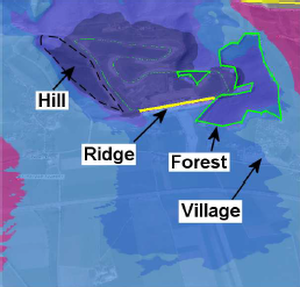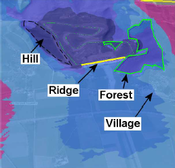Information
- Publication Type: Master Thesis
- Workgroup(s)/Project(s):
- Date: 2013
- TU Wien Library:
- First Supervisor: Eduard Gröller
Abstract
Noise pollution is an ever increasing problem not just in urban environments but also in more rural areas such as small villages, along country roads or even in very sparsely populated regions. The demands of the industry and local governments often clash with the interests of people in the neighborhood, creating areas of conflict that often end up in court. Though in many countries noise assessments are mandatory in order to obtain building permission, these documents are usually not suited or sometimes conceivably not even intended to convey the impact of projects on their environment to the general public. The purpose of this master’s thesis is to propose ways to simulate and visualize noise pollution in large-scale, non-urban environments in order to help communicate the impact of new sound emitters on affected neighbors. Knowledge of noise propagation, the influence of the terrain and other obstacles as well as how different emitters add up can provide valuable insights and help in the decision-making process. This knowledge may be particularly helpful when trying to decide on suitable locations for noise screens and/or when trying to find good places to offset some of the local noise emitters. The tool developed uses NVIDIA’s CUDA architecture and the European norm ISO 9613-2: Attenuation of sound during propagation outdoors to create real-time visualizations in both 2D and 3D. Results are compared against ground truth data obtained by taking noise measurements in the field.Additional Files and Images
Weblinks
No further information available.BibTeX
@mastersthesis{carbesser-2013,
title = "Large-Scale Noise Simulation and Visualization of Moving
Point Sources",
author = "Clemens Arbesser",
year = "2013",
abstract = "Noise pollution is an ever increasing problem not just in
urban environments but also in more rural areas such as
small villages, along country roads or even in very sparsely
populated regions. The demands of the industry and local
governments often clash with the interests of people in the
neighborhood, creating areas of conflict that often end up
in court. Though in many countries noise assessments are
mandatory in order to obtain building permission, these
documents are usually not suited or sometimes conceivably
not even intended to convey the impact of projects on their
environment to the general public. The purpose of this
master’s thesis is to propose ways to simulate and
visualize noise pollution in large-scale, non-urban
environments in order to help communicate the impact of new
sound emitters on affected neighbors. Knowledge of noise
propagation, the influence of the terrain and other
obstacles as well as how different emitters add up can
provide valuable insights and help in the decision-making
process. This knowledge may be particularly helpful when
trying to decide on suitable locations for noise screens
and/or when trying to find good places to offset some of the
local noise emitters. The tool developed uses NVIDIA’s
CUDA architecture and the European norm ISO 9613-2:
Attenuation of sound during propagation outdoors to create
real-time visualizations in both 2D and 3D. Results are
compared against ground truth data obtained by taking noise
measurements in the field.",
address = "Favoritenstrasse 9-11/E193-02, A-1040 Vienna, Austria",
school = "Institute of Computer Graphics and Algorithms, Vienna
University of Technology ",
URL = "https://www.cg.tuwien.ac.at/research/publications/2013/carbesser-2013/",
}




